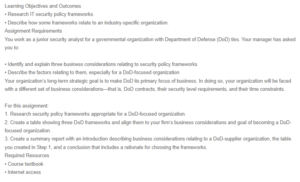Align Security Policy Frameworks to Business Objectives
Frameworks are created in the form of documents that contain descriptions of procedures, practices, and methods to be adhered to by an organization (DoD, 2015). These documents provide guidelines for use within different departments of an organization. Therefore, frameworks are considered as a guide for each task to be performed within an organization. For example, the DoD architecture framework describes how communications, controls, intelligence, computers, commands, and surveillance should be handled within the various departments of the DoD (DoD, 2015). Hence, for a business entity to supply or engage the DoD, the business must synchronize with the DoD architecture framework. An IT security service provider offering software maintenance, cybersecurity services, and data center services would have to comply with computer, intelligence, communication, and surveillance controls. An IT security framework contains all of the frameworks required to govern an organization’s IT infrastructure (Johnson & Easttom, 2022). Notably, a DoD supplier business would ensure it incorporates the required DoD frameworks in its IT security framework to enhance business between the two entities.
Security Policy Frameworks Appropriate for a DoD-Focused Organization
IT security policy frameworks are necessary for the DoD because they cover computer systems, information, data, and users (García et al., 2021). They include risk management, user acceptance, and physical security policies. Firstly, risk management would ensure that risks within the IT infrastructure are identified and mitigated in good time. Mitigation would include risk avoidance, risk acceptance, risk transfer, or risk reduction. Secondly, user acceptance would ensure that all system users in the DoD understand the importance of protecting the system when using it and that they sign a document affirming the same. Lastly, physical security would ensure that IT systems and infrastructure are protected and only accessed by authorized personnel. This would be implemented through access controls such as biometrics, password table rds, work IDs, etcetera.
Dod Frameworks Table
| DoD Framework | Description | Alignment to business | |
| 1. | Meta Model and Architecture Framework | Outlines how data repositories should be designed and implemented (DoD, 2015). | The business should provide data center services and products that align with this framework. That would include consistency, data reuse, cost saving, and |
| 2. | DoDAF Product Development Guidance and Best Practices | Products should be developed in a framework that maintains strong security while meeting client needs (DoD, 2015). | When developing products or providing services to the DoD, the supplier should ensure that all security requirements are met. These requirements would be verified by the DoD’s IT contact persons. For example, pen tests would be conducted to check a system’s robustness before implementation. |
| 3. | Business Intelligence derived from Architecture | This framework requires that DoD systems have interoperability, meaning that different systems used within the DoD should be able to share data without distortion or errors (DoD, 2015). | When providing software solutions for the DoD, a business should implement proper coding to facilitate cross-interaction between the DoD systems. |
Conclusion
In conclusion, a DoD IT supplier business should ensure that it aligns the DoD’s IT framework with its business objectives, as it is the only way the business would be able to supply products and services that are acceptable to the DoD. For example, if systems meet certain criteria, such as interoperability, the supplier must include these requirements in its development. Furthermore, data models and architecture should also be presented as required. Consequently, suppliers should ensure that every framework requirement is met, making the requirements a business objective. In addition, if a DoD framework is updated in the future, the supplier’s deliverables must be revised.
References
DoD. (2015). DoD Architecture Framework. Volume IV: DoDAF Journal, 2.02(1). https://dodcio.defense.gov/Portals/0/Documents/DODAF2/DoDAF%20v2.02%20Chg%201%20Vol%20IV%20Final%202015-01-19.pdf
García, J. E., Encinas, L. H., & Domínguez, A. P. (2021). A Comprehensive Security Framework Proposal to Contribute to Sustainability. Sustainability, 13(12), 1-22. https://www.researchgate.net/publication/352565283_A_Comprehensive_Security_Framework_Proposal_to_Contribute_to_Sustainability
Johnson, R., & Easttom, C. (2022). Security policies and implementation issues (3rd ed.). Jones & Bartlett Learning.
ORDER A PLAGIARISM-FREE PAPER HERE
We’ll write everything from scratch
Question

Align Security Policy Frameworks to Business Objectives
Learning Objectives and Outcomes
▪ Research IT security policy frameworks.
▪ Describe how some frameworks relate to an industry-specific organization.
Assignment Requirements
You work as a junior security analyst for a governmental organization with Department of Defense (DoD) ties. Your manager has asked you to:
▪ Identify and explain three business considerations relating to security policy frameworks
▪ Describe the factors relating to them, especially for a DoD-focused organization
Your organization’s long-term strategic goal is to make DoD its primary focus of business. In doing so, your organization will be faced with a different set of business considerations—that is, DoD contracts, their security level requirements, and their time constraints.
For this assignment:
1. Research security policy frameworks appropriate for a DoD-focused organization.
2. Create a table showing three DoD frameworks and align them to your firm’s business considerations and goal of becoming a DoD-focused organization.
3. Create a summary report with an introduction describing business considerations relating to a DoD-supplier organization, the table you created in Step 1, and a conclusion that includes a rationale for choosing the frameworks.
Required Resources
▪ Course textbook
▪ Internet access


